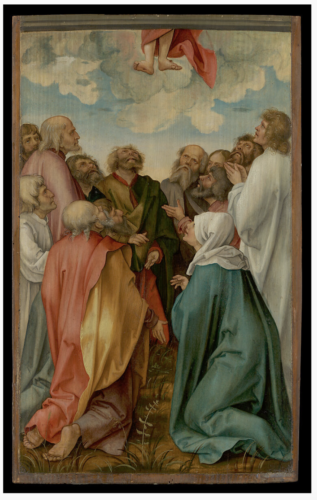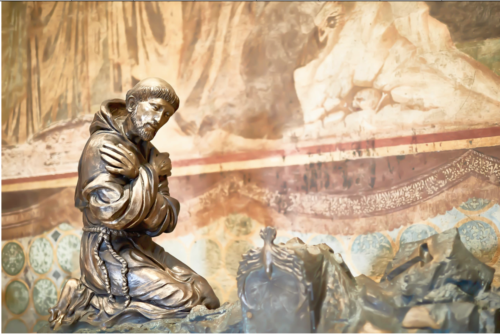Richard Rohr describes how art can serve as a gateway to mystical experience and deeper knowing:
There must be a way to be both here and in the depth of here. Jesus is the here, Christ is the depth of here. This, in my mind, is the essence of incarnation, and the gift of contemplation. We must learn to love and enjoy things as they are, in their depth, in their soul, and in their fullness. Contemplation is the “second gaze” through which we see something in its particularity and yet also in a much larger frame. We know it by the joy it gives.
Two pieces of art have given me this incarnational and contemplative insight. The first is called The Ascension of Christ by Hans von Kulmbach (c. 1480–1522). It portrays the two human feet of Jesus at the very top of a large painting of the Ascension. Most of the canvas is taken up by the apostles, who are drawn up with Christ through their eyes, as his feet move off the top of the painting, presumably into the spiritual realms. The image had a wonderful effect on me. I too found myself looking beyond the painting toward the ceiling of the art museum. It was a mystical moment—one that simultaneously took me beyond the painting and right back into the room where I was standing.

The second piece of art is a small bronze statue of St. Francis, located in the upper basilica of Assisi, Italy. Created by a sculptor whose name is hidden, the statue shows Francis gazing down into the dirt with awe and wonder, which is quite unusual and almost shocking. The Holy Spirit, who is almost always pictured as descending from above, is pictured here as coming from below—even to the point of being hidden in the dirt! God is hidden in the dirt and mud instead of descending from the clouds. This is a major transposition of place. Once we know that the miracle of “Word made flesh” has become the very nature of the universe, we cannot help but be both happy and holy. What we first of all need is here!

Both these pieces of art put the two worlds together, but from different perspectives. Yet in both images, it is the Divine that takes the lead in changing places. Maybe artists have easier access to this Mystery than many theologians. I doubt if we can see the image of God (imago Dei) in our fellow humans if we cannot first see it in rudimentary form in stones, in plants and flowers, in strange little animals, in bread and wine, and most especially cannot honor this objective divine image in ourselves. It is a full-body tune-up, this spiritual journey. It really ends up being all or nothing, here and then everywhere.
The Transformative Power of Art
Father Richard shares his contemplative practice of visiting art museums:
I believe good art has the power to evoke an epiphany. Sometimes, when we can’t take our eyes off a picture or work of art, an epiphany is happening. We don’t yet know what we’re knowing while the wisdom of the unconscious is being ferried across to the conscious mind. Carl Jung said great art presents an “archetypal image.” [1] On one of my very first speaking trips away from Cincinnati, I visited the St. Louis Art Museum. They had an exhibit of Claude Monet’s water lilies; some paintings took up the whole wall. It was a quiet weekday afternoon, and as I went from room to room, I found myself getting quieter and happier, quieter and happier. When I walked out into the sunshine after the exhibit, I felt like I floated home. I wasn’t waiting for an epiphany, but I think I was granted one anyway. I don’t know that I had a new piece of doctrinal information or theological insight, but the experience connected me to something deep and true within. To this day when I’m in a city and have some time free, I go to an art museum.
Folk artist and Living School alumna Lourdes Bernard writes:
Art invites audiences to consider the spirituality and transformative power of images. Engaging art offers respite, contemplation, even as it shares powerful, inspiring, or difficult stories. Art images are real and alive and have the power to change us and cause change.… They can shift our perspective on what we thought we knew and understood about a subject. Too often, art is considered decorative, and it is significantly more than that. Engaging with art means we have to slow down to allow a new experience to enter which perhaps cannot be accessed in another way. It can be an expansive experience. [2]
Richard continues:
I believe good art, good poetry, and true mythology communicates, without our knowing it, that life is not just a series of insulated, unrelated events. The great truths—when they can be visualized in images—reveal deep patterns, and reveal that we are a part of them. That deeply heals us, and it largely happens beneath our conscious awareness. A great story pulls us inside of a cosmic story. If we’re Christian, our cosmic story is the map of the life of Jesus, the divine conception, ordinary life, betrayal, abandonment, rejection, crucifixion, resurrection, and ascension. It all comes full circle. We might not really believe it. We might not have surrendered to it or trust it, but if we can, it makes us much happier people. Our happiness is on a surface level, of course, because suffering is everywhere. We don’t close our eyes to the world’s pain, but on a deep, unconscious level, a cosmic story offers us healing and coherence. Good art gives us a sense that we belong in that story, we belong in that world.
=================
| Second-Guessing God’s Mercy |
DAILY SCRIPTURE JONAH 4:1-4 2 KINGS 5:1-27 WEEKLY PRAYERfrom Basil of Caesarea (330 – 379) May the Father of the true light—who has adorned day with heavenly light, who has made the fire shine which illuminates us during the night, who reserves for us in the peace of a future age a spiritual and everlasting light—enlighten our hearts in the knowledge of truth, keep us from stumbling, and grant that we may walk honestly as in the day. Thus we will shine as the sun in the midst of the glory of the saints. Amen. |